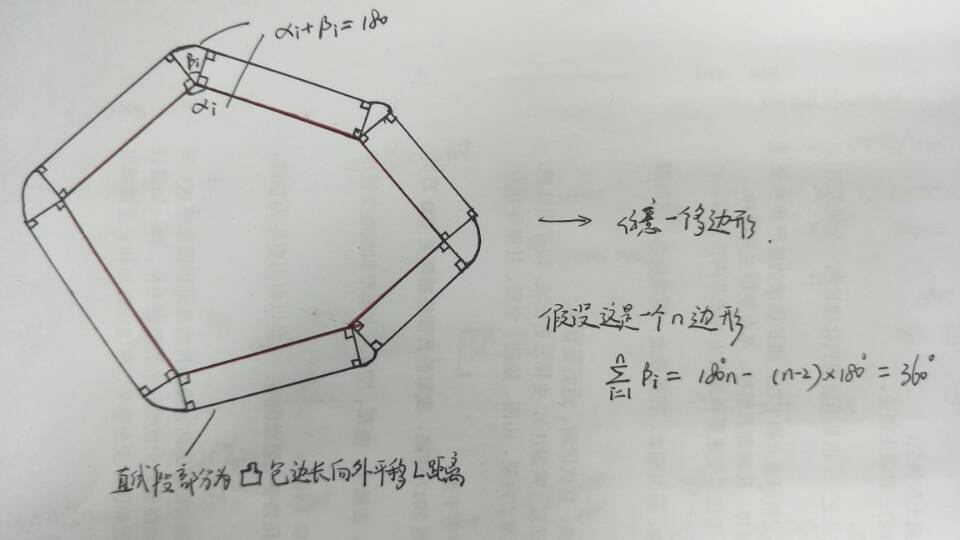<题目链接>
题目大意:
给出二维坐标轴上 n 个点,这 n 个点构成了一个城堡,国王想建一堵墙,城墙与城堡之间的距离总不小于一个数 L ,求城墙的最小长度,答案四舍五入.
解题分析:
求出这些点所围成的凸包,然后所围城墙的长度就为 该凸包周长 + 以该距离为半径的圆的周长。具体证明如下:

下面的模板还没有整理好
Graham 凸包算法

#include<iostream> #include<cstdio> #include<cmath> #include<algorithm> using namespace std; #define maxn 1100 const double pi = acos(-1.0); struct Point { int x, y; }s[maxn]; int st[maxn], top; int cross(Point p, Point p1, Point p2) { return (p1.x - p.x)*(p2.y - p.y) - (p2.x - p.x)*(p1.y - p.y); } double dist(Point p1, Point p2) { double tmp = (p1.x - p2.x)*(p1.x - p2.x) + (p1.y - p2.y)*(p1.y - p2.y); return sqrt(tmp); } bool cmp(Point p1, Point p2) { int tmp = cross(s[0], p1, p2); if (tmp>0) return true; else if (tmp == 0 && dist(s[0], p1)<dist(s[0], p2)) return true; else return false; } void Graham(int n) { if (n == 1) { top = 0; st[0] = 0; } if (n == 2) { top = 1; st[0] = 0; st[1] = 1; } if (n>2) { int i; st[0] = 0, st[1] = 1; top = 1; for (i = 2; i<n; i++) { while (top>0 && cross(s[st[top - 1]], s[st[top]], s[i])<0) //不习惯s[st[top-1]]这种代码风格的可以改一下 top--; st[++top] = i; } } } int main() { int n, l; int ncase; cin >> ncase; while (ncase--) { scanf("%d %d", &n, &l); Point p0; scanf("%d%d", &s[0].x, &s[0].y); p0.x = s[0].x, p0.y = s[0].y; int k = 0; for (int i = 1; i < n; i++) { scanf("%d%d", &s[i].x, &s[i].y); if ((p0.y > s[i].y) || (p0.y == s[i].y&&p0.x > s[i].x)) { p0.x = s[i].x; p0.y = s[i].y; k = i; } } s[k] = s[0]; s[0] = p0; sort(s + 1, s + n, cmp); Graham(n); double ans = 0; for (int i = 0; i < top; i++) { ans += dist(s[st[i]], s[st[i + 1]]); } ans += dist(s[st[0]], s[st[top]]); ans += 2 * pi*l; printf("%d\n", (int)(ans + 0.5)); if (ncase)printf("\n"); } return 0; }
Andrew算法

#include<cstdio> #include<iostream> #include<cstring> #include<cmath> #include<algorithm> using namespace std; const double Pi=acos(-1.0); struct Point{ double x,y; Point(double x=0,double y=0):x(x),y(y){} }; typedef Point Vector; bool operator < (Point a,Point b){return a.x<b.x||(a.x==b.x&&a.y<b.y);} Vector operator - (Point a,Point b){return Vector(a.x-b.x,a.y-b.y);} double Dot(Vector a,Vector b){return a.x*b.x+a.y*b.y;} double Length(Vector a){return sqrt(Dot(a,a));} double Angle(Vector a,Vector b){return acos(Dot(a,b)/Length(a)/Length(b));} Vector Rotate(Vector a,double rad){return Vector(a.x*cos(rad)-a.y*sin(rad),a.x*sin(rad)+a.y*cos(rad));} double Cross(Vector a,Vector b){return a.x*b.y-a.y*b.x;} Point operator + (Point a,Vector b){return Point(a.x+b.x,a.y+b.y);} Point getdot(Point a,Vector b,double ang){return a+Rotate(b,ang);} double getrad(double ang){return Pi*(ang/180);} Point ans[2500],at[2500]; int nu; double polygonArea(){ int k=0; for(int i=0;i<nu;i++){ while(k>1&&Cross(ans[k-1]-ans[k-2],at[i]-ans[k-2])<=0)k--; ans[k++]=at[i]; } int p=k; for(int i=nu-1;i>=0;i--){ while(k>p&&Cross(ans[k-1]-ans[k-2],at[i]-ans[k-2])<=0)k--; ans[k++]=at[i]; } double x=0; k--; if(k<2)return 0; //求该凸多边形面积 for(int i=1;i<k-1;i++)x+=Cross(ans[i]-ans[0],ans[i+1]-ans[0]); return x/2; } int main(){ int T,n; double x,y,w,h,ang; scanf("%d",&T); while(T--){ double area1=0,area2=0; nu=0; scanf("%d",&n); while(n--){ scanf("%lf%lf%lf%lf%lf",&x,&y,&w,&h,&ang); area2+=w*h; //area储存所有矩形的总面积 Point a; ang=-getrad(ang);//因为是顺时针旋转的,所以要是负的。。。。。 at[nu++]=getdot(Point(x,y),Vector(w/2,h/2),ang); at[nu++]=getdot(Point(x,y),Vector(-w/2,h/2),ang); at[nu++]=getdot(Point(x,y),Vector(w/2,-h/2),ang); at[nu++]=getdot(Point(x,y),Vector(-w/2,-h/2),ang); } sort(at,at+nu); area1=polygonArea(); // printf("%lf %lf\n",area1,area2); printf("%.1lf %%\n",100*area2/area1); } return 0; }
2018-08-04
